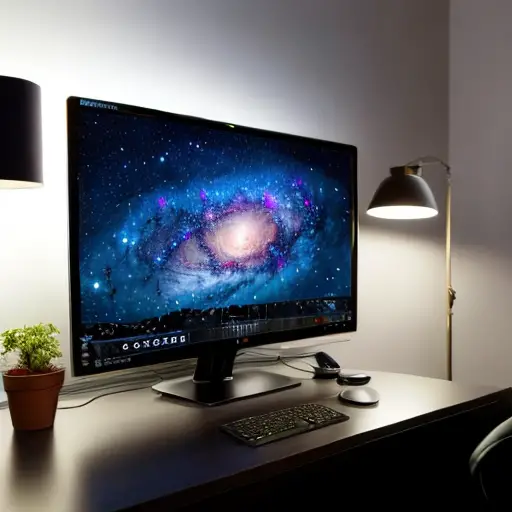Alright, picture this: you're a photo editing wizard, armed with your trusty computer and a cup of coffee that's probably been reheated one too many times. You spend hours perfecting that jaw-dropping landscape shot, only to realize that when you proudly display it on your website, it looks more like a muddy puddle than a work of art. What went wrong? Well, my friend, let me introduce you to the magical world of monitor calibration. You see, calibrating your computer monitor for photo editing is like putting on your glasses before watching a 3D movie – it's essential! By ensuring that your monitor displays colors accurately and consistently, you can bid farewell to those disappointing surprises and hello to vibrant, true-to-life images that will make your audience go 'wow!' So, grab your wizard hat and let's dive into the enchanting realm of monitor calibration!
An interesting fact about calibrating a computer monitor for photo editing is that the process involves adjusting the monitor's color settings to ensure accurate and consistent representation of colors. This is done by using a colorimeter, a device that measures the color output of the monitor and creates a color profile. However, it is important to note that the human eye perceives colors differently under different lighting conditions, so it is recommended to calibrate the monitor in a controlled environment with consistent lighting to achieve the most accurate results.
Alright, fellow photo editing enthusiasts, let's embark on a journey to achieve color perfection! Step one: find a quiet space, free from distractions (yes, that means no Netflix in the background). Step two: grab a trusty monitor calibration tool, like a colorimeter or spectrophotometer. Step three: adjust your monitor's brightness and contrast settings to a comfortable level. Step four: run the calibration software and follow the prompts, allowing it to work its magic. Step five: sit back, relax, and let the software work its wonders, analyzing your monitor's color accuracy and making necessary adjustments. Step six: voila! Your monitor is now calibrated, ready to showcase your photos in all their true, vibrant glory. So, go forth, my friends, and let your creativity shine with accurately represented colors!

Are you ready to take your photo editing game to the next level? Buckle up, because we're about to dive into the realm of advanced monitor calibration techniques. Once you've mastered the basics of monitor calibration, it's time to fine-tune those settings for enhanced precision and accuracy. First up, let's talk about gamma adjustment. Gamma refers to the brightness levels of different shades of gray, and tweaking this setting can make a world of difference in your photo editing workflow. By adjusting the gamma to the appropriate level, you can ensure that your shadows and highlights are displayed accurately, allowing you to make more informed editing decisions.
Next on our journey is color temperature. This setting determines the overall warmth or coolness of your monitor's display. By calibrating the color temperature to the desired value, you can achieve a more consistent and pleasing color representation. Whether you prefer a cooler, bluish tone or a warmer, reddish hue, fine-tuning the color temperature will help you maintain a consistent look across your edited photos.
Now, let's talk about contrast ratio. This refers to the difference between the darkest and lightest areas of your monitor's display. Adjusting the contrast ratio can help you achieve a more dynamic and visually appealing image. However, it's important to strike a balance – too much contrast can result in loss of detail in shadows or blown-out highlights. Experiment with different contrast settings until you find the sweet spot that enhances your photos without sacrificing important details.
Last but not least, let's explore the world of color calibration. While basic monitor calibration ensures accurate color representation, advanced techniques allow you to fine-tune specific colors to achieve a desired look. This can be particularly useful when working with specific color profiles or when aiming for a consistent color scheme across multiple images. By adjusting individual color channels, such as red, green, and blue, you can achieve a more precise and customized color representation that truly brings your photos to life.
So, my fellow photo editing enthusiasts, don't be afraid to venture into the realm of advanced monitor calibration techniques. By fine-tuning your monitor settings for enhanced precision and accuracy, you'll be able to take your photo editing skills to new heights and create stunning visuals that will leave your audience in awe. Happy editing!
A fun fact about calibrating a computer monitor for photo editing is that you can use a specific tool called a colorimeter to achieve accurate color representation. This device measures the color output of your monitor and creates a custom color profile for it. It's like giving your monitor a pair of 'glasses' to see colors more accurately!
Consistency is key when it comes to photo editing, and regularly calibrating your monitor is the secret ingredient to achieving optimal results. Just like a well-oiled machine, your monitor needs regular maintenance to ensure it's performing at its best. Set a reminder to calibrate your monitor every few weeks or at least once a month to maintain accurate color representation. Additionally, keep an eye on environmental factors that can affect your monitor's performance, such as changes in ambient lighting or dust accumulation. By staying on top of regular calibration and monitoring your workspace conditions, you'll be able to maintain a consistent editing environment and produce stunning, true-to-life images time and time again.